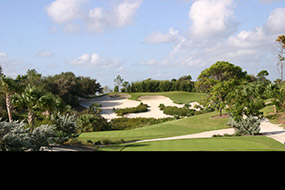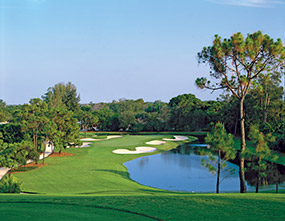Half an hour north of Palm Beach, the Jupiter Hills Club was established in 1969 following a complicated three-way deal that involved its founding members purchasing land for the State of Florida in exchange for a section of scrubland at the southern end of the Jonathan Dickinson State Park. One of those founding members was George Fazio, who had identified these dunes as suitable for golf and then assembled the financiers required to make the necessary purchases. He also designed the club’s Hills Course, which opened in 1970 but was altered a few years later when three of its holes were used to complete the club’s second layout.
What attracted Fazio to this property was a natural 60-foot dune ridge that cut across the site, the highest in southern Florida. As well as the size and purity of the sand, there was also an abundance of pine, oak and palmetto which helped create the ideal setting for the style of golf desired by the membership. Not surprisingly, the large dunes dominate this golf course, particularly around its central regions where holes are routed into, along or beside the sandhills. The opening hole actually dives off the ridge and heads out toward the less impressive newer holes, which are located down on the flatter areas. An elevated approach into the 6th green reintroduces golfers to the main sand structure, with the next two holes also boasting exciting cross-valley approach shots and raised green sites benched into the dunes. For most, however, the outward nine highlight is the notorious 9th, a severe uphill par three that is usually played with a long-iron or fairway wood and heads across a sprawling scrub bunker toward a target perched more than 30 feet above the tee.
Aside from a couple of fairly nondescript longer holes away from the main ridge, the back nine is more consistently undulating and exciting. The sweeping, side-hill 10th is a solid starting point and neighboring holes at the 11th and 14th are both respectable pond par threes. The best and most demanding golf, however, comes closer to the finish. Both the 16th and 18th are strong par fours with extremely steep approach shots, each rising almost vertically across bunkered slopes and into small greens near the top of the dunes. Sandwiched between is a long two-shotter that tumbles down and around this higher ground, any golfers able to end their day with pars on these three closing holes are generally ecstatic.
Although George Fazio’s design has remained largely unaltered over the years, major hurricanes at the turn of the century destroyed hundreds of sand pines and altered the look, feel and challenge of his holes. During 2006 his nephew Tom Fazio was employed to restore and modernize the Hills Course. Aside from adding 400 yards to the layout, he tightened several target areas and exposed more of the native wastelands. The club also reduced the par by two shots for those playing from the back tee markers, making it again one of the most difficult tests in the region.
Jupiter Hills may not have the subtlety of a Seminole, or ask the same sort of strategic questions, but the terrain here is naturally suited to golf and the number of exciting dune shots help to keep it among Florida’s most popular courses.

 this course also has exceptional:
this course also has exceptional:

